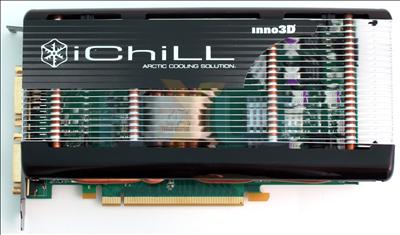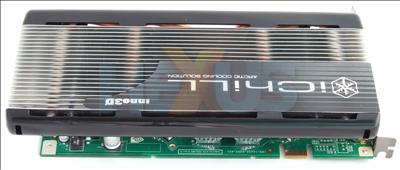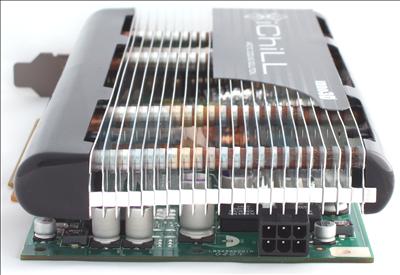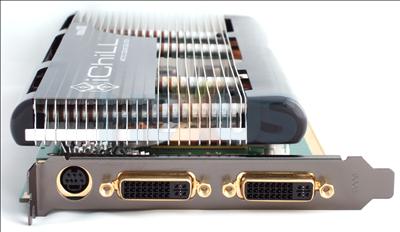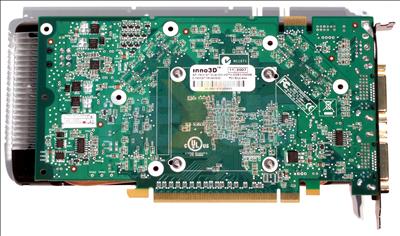Appearance and thoughts
A word or two on the GeForce 7950GT GPU first. It's based on the NVIDIA G71 architecture that we covered in detail just over a year ago. In short, it supports DX9 SM3.0 spec, has 24 pixel processors, 8 vertex shaders, and 16 ROPs. Core and memory speeds for the range-topping 7900 GTX stood at 650MHz/1600MHz, respectively, with a 256-bit memory bus providing a juicy 56.32GB/s of bandwidth. The 'GT SKU was simply a lower-clocked version (450/1320) of GTX.
NVIDIA then slipped in the GeForce 7950GT in September 2006. The revised SKU increased the GT's clocks to 550/1400 and added a quieter cooler and HDCP support as standard. Initial cards were available in 512MiB framebuffer flavours, but, recently, AICs have been pushing out cheaper 256MiB-equipped models.
Now, GeForce 7950GT would have remained an attractive proposition at around £175 if ATI hadn't taken a hacksaw to its Radeon X1950 XT 256MiB pricing and, more importantly, NVIDIA hadn't dropped a bombshell by releasing the utterly compelling GeForce 8800 series.
The recent introduction of the GeForce 8800 GTS 320, priced at around £180, has put considerable pressure on AICs to shift the last of their G71 allocation, so that's why, we suppose, Inno3D is still promoting this midrange model.
Inno3D iChiLL 7950GT Accelero S1M
What's immediately obvious is that Inno3D has taken this upper midrange SKU and bolted on a quad-heatpipe-based heatsink designed by the folks at Arctic Cooling. Interestingly, this particular cooler - Accelero S1M - doesn't appear on AC's site, with the Accelero S2, usually seen on low-end models, presented as the only silent solution.
This iChill card runs at 560MHz core and 1500MHz memory, up from the default's 550/1400. The G71 SKU runs quite warm, so we can see why Inno3D opted for the Accelero S1M. The single-sided heatsink is longer than the PCB, and the alumimiun fins, connected to the heatpipes, gives Inno3D the confidence to launch a (slightly) pre-overclocked passively-cooled card.
We've looked at a number of other GeForce 7950GT cards in the last few months. Here's how they stack up in terms of idle and load temperatures.
| Graphics cards | Inno3D iChiLL 7950GT 256MiB (560/1500) | Inno3D GeForce 7950GT Zalman Edition 512MiB (550/1400) | Foxconn GeForce 7950GT 512MiB (550/1400) | XFX GeForce 7950GT Extreme Edition 512MiB Passive (570/1460) | XFX GeForce 7950GT Extreme Edition 512MiB Passive (610/1600) |
|---|---|---|---|---|---|
| Ambient temperature | 21°C | 22°C | 21.5°C | 17.5°C | 20.5°C |
| Idling temperature | 38°C | 47°C | 50°C | 48°C | 51°C |
| Load temperature | 52°C | 69°C | 73°C | 69°C | 69°C |
Going by the data above, the Accelero S1M is a hugely efficient heatpipe-based design that wipes the proverbial floor with cards featuring both reference and passive heatsinks (XFX). Our testing platform has an Akasa 120mm fan blowing over the motherboard, with the main thrust aimed towards the right of the PCIe slots, so whilst it's helping in wicking away the heat from the Accelero S1M heatsink, the effect is only partial.
A look at the other side further indicates just how large the Accelero S1M is.
One interesting aspect of utilising the Accelero cooler, replete with protective plastic surrounds, lies with the inability to correctly install the rigid-style SLI bridge between two cards, should you wish to run them in SLI on an appropriate motherboard. The 'hard' bridges ship with most new motherboards, so you may need to source the 'soft' variety (ribbon cable-esque) if hooking up SLI in silence is your aim, assuming you can find one long enough to correctly fit on to an nForce 680i motherboard.
Plugging in the 6-pin PCIe power connector presented no problems, though.
A look at the rear highlights one of the iChiLL's signature touches: gold-plated dual-link DVI connectors. Both support HDCP - a GeForce 7950GT requirement.
What the above picture also highlights is the dual-slot-taking nature of the heatsink, meaning the expansion slot adjacent to the PCIe x16's will be rendered useless.
Nothing of great note on the back.






